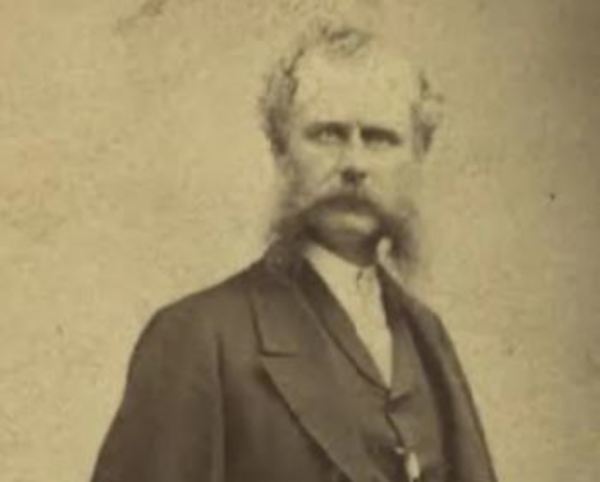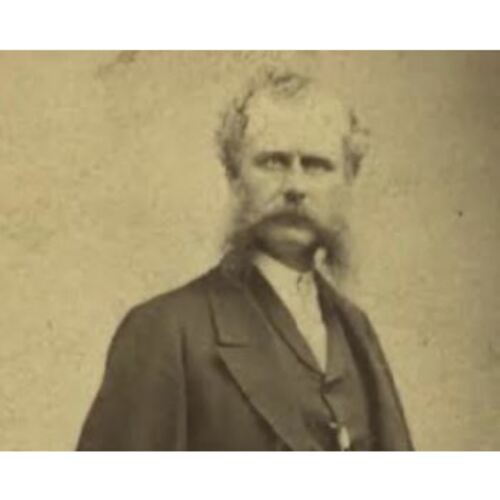
Source: Link
EARLE, SYLVESTER ZOBIESKI (the second name sometimes appears as Sobieski, Zolieski, and Solieski, but he signed Zobieski), physician and municipal politician; b. 7 Aug. 1822 at Kingston, Kings County, N.B., son of Sylvester Zobieski Earle and Maria Hughson; m. in 1847 Catherine McGill Otty, and they had eight children; d. 1 March 1888 in Saint John, N.B.
Sylvester Zobieski Earle, the grandson of a loyalist merchant and the son of a doctor and assemblyman, received his early education in Kings County. He then chose his father’s profession and studied medicine at the University of the City of New York. Awarded the degree of md in 1844, Earle visited a number of medical centres in Europe before he returned to New Brunswick in 1845 and received his practitioner’s licence. He joined his father in practice at Hampton, Kings County, was married in 1847, and ten years later was appointed county coroner. Earle also became involved in the militia. When he moved to Saint John in 1864 he joined the 62nd Saint John Fusiliers, and after being commissioned surgeon to the unit in February 1866, saw active service during the Fenian raid that year.
Earle had a successful medical practice in Saint John and played a significant role in such fraternal societies as the masonic order as well as in the militia. In April 1877 he was elected mayor of the city and soon after encountered some jurisdictional difficulties with members of the common council, caused primarily by his lack of experience in civic government. This skirmish was quickly forgotten, however, in the total disruption caused by the great fire which ravaged Saint John on 20–21 June 1877.
The fire was first discovered on a wharf in the city’s waterfront and business district. Before it was contained the next day it had destroyed the most densely populated and prosperous part of the city and spread through more than nine miles of streets containing 1,612 buildings. Thirteen thousand people were left homeless, 19 people were thought dead, and contemporary estimates put the material loss at $27 million, only $7 million of which was covered by insurance. Cash donations and supplies soon arrived from throughout North America and the British Isles and Mayor Earle, whose home and office had escaped the conflagration, benefited from the advice of the chairman of the Chicago relief committee which had been formed in the aftermath of that city’s destructive fire a few years earlier. Earle reorganized the Saint John Relief and Aid Society which housed citizens in a skating rink and in “tent cities” and disbursed money, food, clothing, and furniture to the destitute. Looting was widespread, with the police discovering large quantities of goods concealed in houses outside the city, and rumours circulated that ships “laden with spoils from the fire” were heading towards other Maritime ports. On 22 June Earle appealed for help directly to the military commander at Halifax, Lieutenant-General William O’Grady Haly*, and approximately 140 soldiers were dispatched to Saint John. The general pointed out, however, that Earle’s request should have been transmitted through New Brunswick’s lieutenant governor, Samuel Leonard Tilley*.
The citizens of Saint John praised Earle’s efforts, and in 1878 he was re-elected mayor. A highlight of the reconstruction campaign was the laying of the corner-stone of the new city hall on 29 May 1878. But many residents left the city, and it has been estimated that Saint John did not recoup its loss in population until 40 years after the fire. Moreover the calamity occurred at a time when wooden shipbuilding, Saint John’s major industry, was being surpassed by the new technology of steam and steel. It is possible that the economic and social dislocation caused by the 1877 fire simply accelerated the decline which the city underwent in the late 19th century. Mayor Earle was criticized, especially by the merchant community, for not acting more quickly in rebuilding the city’s vital waterfront, and it was said that he lacked economic acumen in his discussions with the federal government over financial relief for the port. No immediate federal assistance was provided for its reconstruction. When Earle sought a third term as mayor in 1879 he was defeated.
Earle continued to act as a coroner for Saint John County, a position he had held since 1867, and in 1882–83 was president of the New Brunswick Medical Society. At his death in 1888 he was a commissioner of the General Public Hospital and of the board of health and the president of the New Brunswick Council of Physicians and Surgeons.
N.B. Museum, M. G. Otty coll., Earle family papers, geneal.; Otty family papers; Tilley family papers. PANB, Common Council of Saint John, Minutes and papers, 1841–1955. St Paul’s Anglican Church (Hampton, N.B.), Records (mfm. at PANB). Historical records of the 62nd St. John Fusiliers (Canadian militia), comp. E. T. Sturdee (Saint John, N.B., 1888). Saint John, Annual report of the corporation of the city, 1877–79. Morning News (Saint John), 1877–78, 2 March 1888. Saint John Daily Sun, 2 March 1888. Saint John Globe, 2 March 1888. Canadian biog. dict., II. Hutchinson’s New Brunswick directory for 1865–1866 . . . , comp. Thomas Hutchinson (Montreal, [1866]). McAlpine’s St. John city directory (Saint John), 1876, 1887–88. W. F. Bunting, History of St. John’s Lodge, F. & A.M., of Saint John, New Brunswick, together with sketches of all Masonic bodies in New Brunswick, from A.D. 1784 to A.D. 1894 (Saint John, 1895). Esther Clark Wright, The loyalists of New Brunswick (Fredericton, 1955; repr. Moncton, 1972). R. H. Conwell, History of the great fire in Saint John (Boston, 1877). K. F. C. MacNaughton, The development of the theory and practice of education in New Brunswick, 1784–1900: a study in historical background, ed. A. G. Bailey (Fredericton, 1947). George Stewart, The story of the great fire in St. John, N.B., June 20th, 1877 (Toronto, 1877). W. B. Stewart, Medicine in New Brunswick . . . (Moncton, N.B., 1974). The University of New Brunswick memorial volume . . . , ed. A. G. Bailey (Fredericton, 1950).
Cite This Article
Elizabeth W. McGahan, “EARLE, SYLVESTER ZOBIESKI (Sobieski, Zolieski, Solieski),” in Dictionary of Canadian Biography, vol. 11, University of Toronto/Université Laval, 2003–, accessed April 1, 2025, https://www.biographi.ca/en/bio/earle_sylvester_zobieski_11E.html.
The citation above shows the format for footnotes and endnotes according to the Chicago manual of style (16th edition). Information to be used in other citation formats:
| Permalink: | https://www.biographi.ca/en/bio/earle_sylvester_zobieski_11E.html |
| Author of Article: | Elizabeth W. McGahan |
| Title of Article: | EARLE, SYLVESTER ZOBIESKI (Sobieski, Zolieski, Solieski) |
| Publication Name: | Dictionary of Canadian Biography, vol. 11 |
| Publisher: | University of Toronto/Université Laval |
| Year of revision: | 1982 |
| Access Date: | April 1, 2025 |



